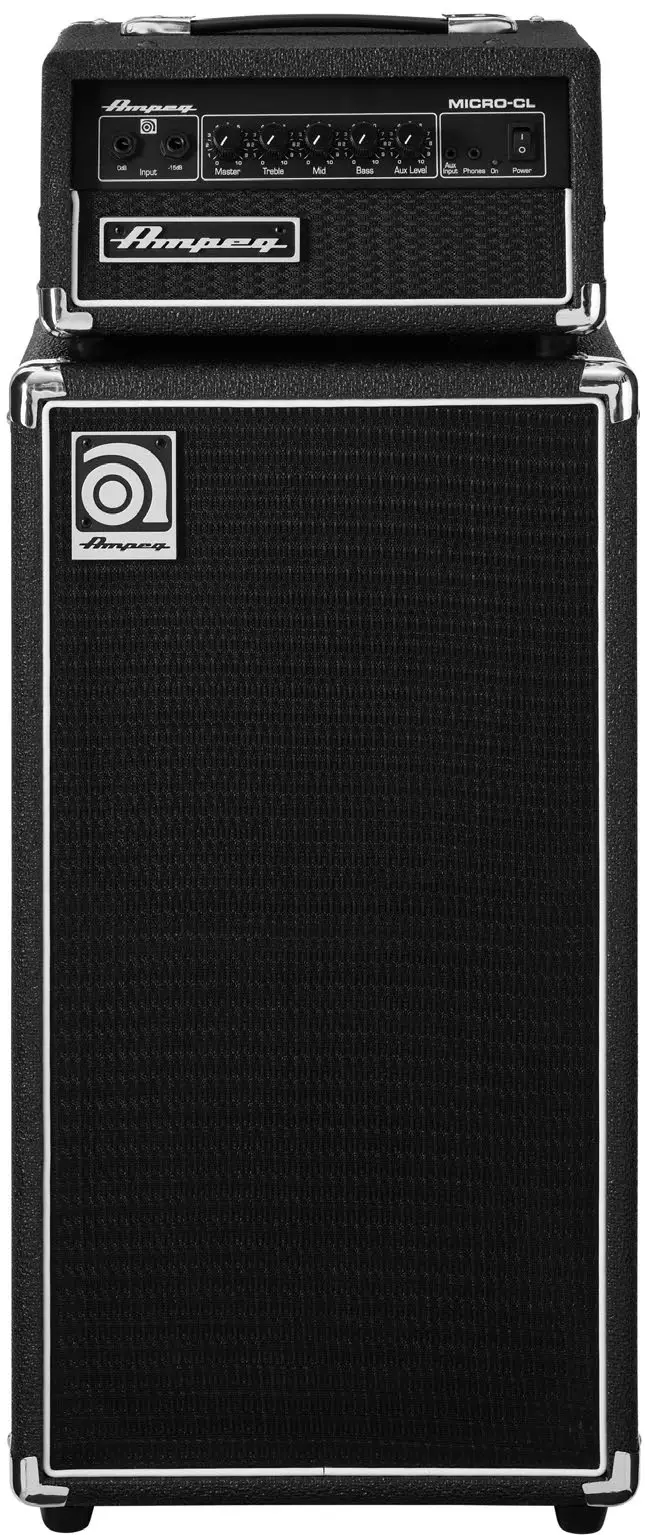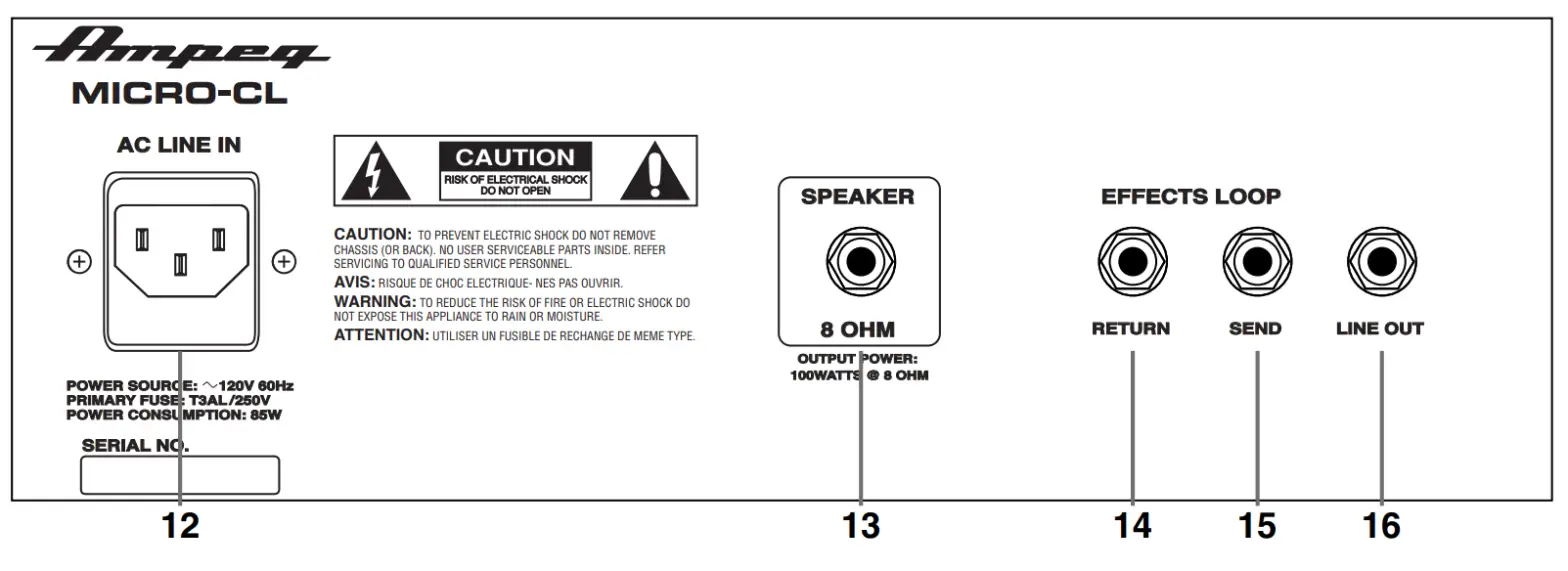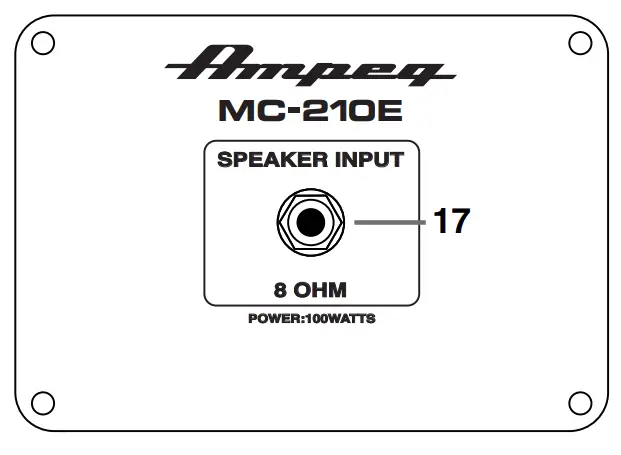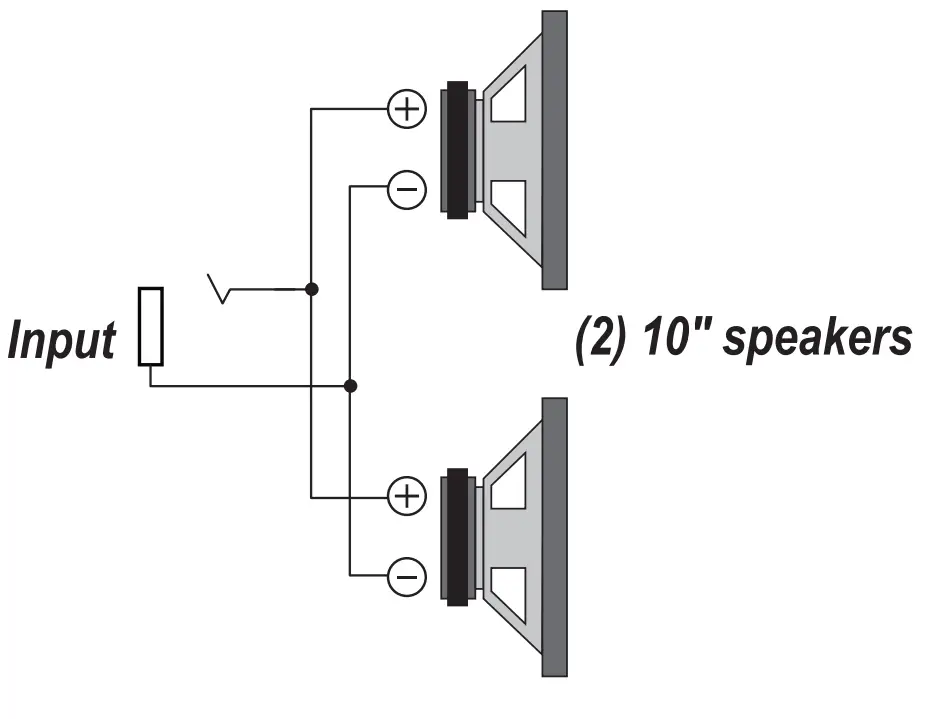MICRO-CL Stack
 Owner’s Manual
Owner’s Manual
What’s in the Box
- MICRO-CL Amplifier and Speaker Cabinet,
- Speaker Cable,
- Power Cable,
- Quick Start Guide.
Introduction
Let’s face it. You are the type who would happily crank up a full Ampeg SVT® stack in your living room. Heck, who needs neighbors, anyway? And noise violations are really just a badge of honor, right? For the rest of us, there is the Ampeg MICRO-CL Stack, delivering 100 watts of Ampeg tone into any situation. It’s perfect for those just getting into Ampeg tone or for the seasoned bassist looking to practice in far-flung locations, like the master bathroom. The MICRO-CL Stack features a tough, 2×10″ cab and tools like stereo input and output for silent practice, effects loop, and direct out for recording. It’s everything you want in a full-stack, micro-sized to fit perfectly into your life.Like all Ampeg products, the MICRO-CL Stack was designed by musicians and built using only the best of components. Each stack is tested to confirm that it meets our specifications, and we believe that this product is the absolute best that it can be.In order to get the most out of your MICRO-CL Stack, please fully read this Owner’s Manual, as well as the Important Safety Instructions, included with the product, beforeplaying.Best of luck in all of your musical endeavors!Sincerely,The dedicated team at Ampeg
Features
Amplifier:
|
|
Speaker Cabinet:
|
|
The Front Panel

1. 0 dB INPUT: The signal output from a passive instrument may be connected to this 1/4″ Input by means of a shielded instrument cable.2. –15 dB INPUT: The signal output from an active instrument may be connected to this 1/4″ input by means of a shielded instrument cable.3. MASTER: Use to control the output level of the instrument only.It affects the Speaker Output [13] and Headphones Output [9]. Use it wisely and turn it down when making connections, putting on headphones, or trying something new.4. TREBLE: Use to adjust the high-frequency level of the amplifier. This provides up to 13 dB of boost, or 13 dB of cut, at 6 kHz. The high-frequency output is flat at the center position.5. MID: Use to adjust the midrange frequency level of the amplifier. This provides up to 11 dB of boost, or 11 dB of cut, at 600 Hz. The midrange frequency output is flat at the center position. Rotate the control counterclockwise for a “contoured” sound (more distant, less midrange output) or clockwise for a sound that really cuts through.6. BASS: Use to adjust the low-frequency level of the amplifier. This provides up to 11 dB of boost, or 11 dB of cut, at 50 Hz. The low-frequency output is flat at the center position.7. AUX LEVEL: Use to control the output level of the signal fed to the Aux Input [8]. Use it wisely and turn it down when making connections, putting on headphones, or trying something new.8. AUX INPUT: The audio output from line-level sources such as a mobile device or MP3 player can connect to this 1/8″ TRS stereo input. The incoming audio is mixed with the preamp signals, so you can play along to a practice track while listening with headphones. (The audio here appears in the cabinet speakers until headphones are plugged in; then heard in the headphones only).9. PHONES: Use this 1/8″ TRS stereo output to connect headphones. The output here is a mix of the line-level signals reaching the amplifier, plus any incoming audio from the Aux In jack [8].![]() Before putting on headphones, make sure the Master control [3] and Aux Level [7] are turned down. This will reduce the chance of hearing damage due to loud volumes.Note: The speaker is muted when headphones are plugged in.10. ON LED: This LED illuminates red when the power is on.11. POWER SWITCH: Use this switch to turn the overall system power on or off.Press the top of the switch to turn on the power, and press the bottom of the switch to turn it off.
Before putting on headphones, make sure the Master control [3] and Aux Level [7] are turned down. This will reduce the chance of hearing damage due to loud volumes.Note: The speaker is muted when headphones are plugged in.10. ON LED: This LED illuminates red when the power is on.11. POWER SWITCH: Use this switch to turn the overall system power on or off.Press the top of the switch to turn on the power, and press the bottom of the switch to turn it off.
The Rear Panel


12. AC POWER INPUT: The amplifier is equipped with a detachable power cable that plugs into this IEC Mains socket on the back of the amplifier. The AC power cord should only be plugged into a grounded power outlet that meets all applicable electrical codes and is compatible with the voltage, power, and frequency requirements stated on the rear panel of the amplifier.![]()
![]()
![]()
Rear Panel Connector Plate


17. 1/4″ TS INPUT JACK: Connect the speaker-level output [13] to this speaker input jack using a (non-shielded) speaker cable.Always use a (non-shielded) speaker cable—never use a (shielded) instrument cable to connect speakers to an amplifier.
System Block Diagrams
Amplifier:


Speaker Cabinet:


Technical Specifications
| Output Power Rating | 100 Watts @ 8Ω |
| Signal to Noise Ratio | 72 dB (20 Hz – 20 kHz, unweighted) |
| Maximum Gain | 59 dB at 1 kHz |
| Amplifier Inputs | 2 x 1/4″ Jacks [OdB, -15dB]2 x 1/8″ Jacks [Aux, Headphones] |
| Tone Controls | Bass: +11/-11 dB @ 50 HzMidrange: +11/-11 dB @ 600 HzTreble: +13/-13 dB @ 6 kHz |
| Power Requirements | Japan: 100V -50-60 Hz, 85W U.S.: 120V -60 Hz, 85WEU: 220-240V -50-60 Hz, 85W |
| Amplifier Size (H x W x D) | 7 in/178 mm (with feet) x 12.2 in/310 mm x 10 in/254 mm |
| Amplifier Weight | 13.8 lb / 6.3 kg |
| Cabinet Frequency Response | 57 Hz – 5 kHz |
| Cabinet Sensitivity | 100 dB SPL @ 1W/1m |
| Cabinet Input | 1 x 1/4″ Jack |
| Speaker Specs | 2 x 10″ LF drivers |
| Cabinet Size (H x W x D) | 13 in/330 mm (with feet) x 24 in/610 mm x 11 in/279 mm |
| Cabinet Weight | 33.2 lb / 15.1 kg |
The MICRO-CL is covered with a durable, fabric-backed vinyl material. Clean with a dry, lint-free cloth. Never spray cleaning agents onto the stack. Avoid abrasive cleansers which would damage the finish.Ampeg continually develops new products and improves upon existing ones. For this reason, the specifications and information in this manual are subject to change without notice.
Warranty and Support
Visit WWW.AMPEG.COM to…
- …identify WARRANTY coverage provided in your local market. Please keep yoursales receipt in a safe place.
- ...REGISTER your product.
- …CONTACT Technical Support, or call 818-575-3600.


![]()
![]()
Serial Number: _______________________________
References
[xyz-ips snippet=”download-snippet”]

